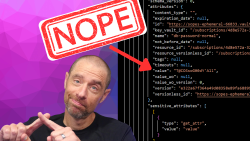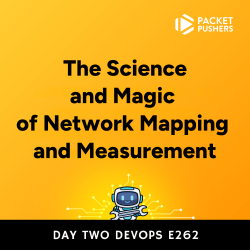


As 2022 winds to a close, it’s time to reflect back on the year. There were some triumphs, some failures, and a fair bit of frustration as I continue to try and figure out what Ned in the Cloud LLC should focus on and what I should avoid. If there’s one thing to take away from 2022, it’s that in 2023 I should endeavor to do less. This is not exactly a new problem for me and I think I’m handling my overall workload better now than in previous years. I’m no longer the panicking new business owner in my first year of operation just praying that I can keep the lights on. Financially, Ned in the Cloud had a banner year - more on that later - and that tells me I can slow down a little and enjoy the journey.
I like the format I used for the post last year, so let’s do it again. First I’ll focus on my various technical education endeavors. Then we can look at some of my failures. Finally, I’ll talk about some of the things I’m looking forward to in 2023.
The primary focus of Ned in the Cloud is to provide entertaining and engaging technical education. Measuring success is a function of how well I’ve met that goal. By that measure, I think I can declare 2022 a resounding success!
One of my goals for 2022 was to get back to regular video production on my YouTube channel. How did I do? I managed to publish 13 new videos, which comes out to about one a month. My hope was to come closer to two a month, and I did not reach that goal. Nevertheless, the videos I created amassed 21k views! My most successful video of the year was “Choosing Between Count and For-Each”, which tells me that Terraform fundamentals will always do better than niche content like “Using OIDC with GitHub Actions and Terraform”.
Taking the wider view of all my video content, I had over 167k views for over 15k hours and picked up 4k subscribers, more than doubling my subscriber count in 2021. This is all despite producing less overall videos. I’m starting to suspect that it’s quality over quantity! What was my #1 video for 2022? It was a close tie between “Getting Started with GCP and Terraform” and “Azure DevOps Pipeline with Terraform”.
I have two key takeaways from my YouTube channel this year. First, I should focus on fundamentals, like “Getting Started” or investigating a specific feature of Terraform. Second, more is not always better and consistency of release cadence is a fool’s errand. I was sporadic at best and still doubled my subscribers.
Still though, for 2023, I would like to meet the two videos a month goal. I plan to stick with Terraform for one of them, and then maybe start back up with HashiCorp Vault for the other. Or maybe I’ll get into a new solution? (That’s foreshadowing for a future post in case you weren’t sure)
Day Two Cloud had a great year in terms of shows and sponsorships. Revenue increased by almost 70% over the previous year. Seriously, D2C has become a major source of revenue for Ned in the Cloud, and that makes me feel like we’re doing something right. Vendors want to advertise with us and listeners enjoy what we’re creating! We had a total of 420k downloads, with each episode being downloaded an average 10k times- excluding the most recent episodes that haven’t had their “long tail” grow yet.
There were so many great episodes this year. Here are five that I particularly enjoyed!
There’s also one more episode I’d really like to recommend. Ethan and I did a mental health episode with just the two of us sharing our experience of IT burnout, panic attacks, and dealing with anxiety. It was impromptu and brutally honest.
We already have two months worth of episodes in the can for 2023, and already there are some amazing episodes in store. I’m hoping to keep growing the Day Two Cloud audience and finding amazing guests to put in front of your ears.
Is it better to burn out or fade away? For The Daily Check-In podcast, I chose an Irish Goodbye. No big brouhaha, since I’m not going anywhere. But keeping up a daily cadence on a podcast just wasn’t in the cards. The final episode dropped on February 22nd, and ironically it was about bringing back the Buffer Overflow podcast that I used to do with coworkers at my previous employer. Speaking of which…
Is it called Buffer Overflow? No. Is it basically the same show? Kinda. Buffer Overflow was originally me and Chris Hayner exploring tech topics and explaining why they were all terrible. At some point we added two more cohosts, Kim and Brenda, to provide flexibility for scheduling and content. Then I left the company and got busy with other things. We shuttered Buffer Overflow in April 2021, and that was that.
By September of 2021, Chris and I had started talking about maybe resurrecting the podcast with just the two of us for simplicity. We had a clear vision of what we wanted the show to be and where we wanted to take it. But I was busy with other projects and Chris was still working full time for our shared previous employer.
In 2022, circumstances changed. I stopped doing The Daily Check-In. Chris quit his job and decided to become an independent consultant. And now suddenly resurrecting Buffer Overflow was a real possibility. We decided to call it Chaos Lever instead, to avoid any potential trademark issues, and did a soft launch of the podcast on March 22nd.
Since that time, we’ve been releasing weekly episodes on a consistent basis and slowly growing the subscriber base. There are no current plans to monetize the show, but I wouldn’t rule it out. Regardless, it keeps the two of us out of trouble- or at least keeps us in a manageable kind of trouble, and that’s enough justification on its own.
In 2023, I’d like to focus on growing the audience. We’re going to try out a newsletter and maybe we’ll play with video? I dunno, we both have faces for podcasting. If you head to the Chaos Lever website, you should find a form to sign up for the newsletter.
Sometime in 2008, I attended a training class for Exchange Server 2007. Compared to previous versions of Exchange, the 2007 release was a major departure. Microsoft had completely changed the internals of Exchange, introducing multiple roles and layers, and the interaction model, shifting from a heavyweight console to a web UI and PowerShell. It’s not a stretch to say that the modern era of PowerShell was fueled by Exchange 2007 and also VMware’s PowerCLI.
What does any of this have to do with HashiCorp? Nothing directly. This was the first live training I had attended as an IT Professional and the instructor was amazing. He had deep knowledge of the product and all of the ancillary components. He kept the delivery engaging, even when discussing fairly dry and mundane concepts. And he was more than happy to field questions and give detailed answers. Somewhere in the back of my head the seed was planted, I wanted to be like this guy.
At the time I didn’t appreciate how that seed would grow and flower into a full-blown career. I was basing my career path off that of my boss, who had spent about ten years in tech before becoming the head of technology for the SMB I was now employed by. I thought that was what the future held for me. I would spend a few more years honing my technical skills and them move to a leadership role at another company. I even enrolled in an MBA program because I thought it would help me advance my career as I transitioned to management.
Long story short, since this section has gone on longer than I intended, I never went into management. I ended up in consulting for six years, and during that time I started producing courses for Pluralsight in 2017. It wasn’t classroom training being delivered live, but I was now a trainer of sorts. Clearly, my drive to create educational content for technical folks became a central pillar of my career, and led me to create Ned in the Cloud LLC in 2019. But I still wasn’t doing the live training that inspired me over a decade prior. This year, that changed.
I mentioned in last year’s post that I had produced some private training videos for River Point Technologies. They are a HashiCorp training partner and deliver live training for HashiCorp products like Terraform, Vault, and Consul. I asked them if they needed help with their live training, and the answer was a resounding and enthusiastic, “Yes!”
So I started delivering live trainings for Terraform and Vault to private companies and for HashiCorp Academy. Over the course of 2022, I have conducted 15 live training sessions via Zoom for groups of 10-20 people.
This was my first foray into live instruction, and I was more than a little nervous for the first few trainings in February and March, but I quickly found my footing. I love the interactive nature of live training. The fact that I get feedback and questions from the class is amazing! It forces me to know even more about Terraform and Vault, and also provides fodder for future videos and blog posts. I’m excited to go back and update my Pluralsight courses based on what I’ve learned as an instructor.
I plan to keep teaching live classes in 2023, and I wouldn’t be opposed to doing one or two in person. Zoom’s nice and all, but I bet it would be even better being in a room with actual humans.
In 2021, I signed on to deliver a series of liveProjects for Manning publishing. This is the beginning of a trend wherein Ned commits to a large project and ends up regretting it. Manning liveProjects are a really great idea. Instead of passively reading a book and maybe walking through some pre-built labs and exercises, liveProjects have you building actual solutions from scratch based off requirements and guidance from the author. You’re presented with a goal, criteria for success, and access to some of Manning’s books for reference. If you get stumped, there are partial and full solutions available, but the goal is to think things through and try to design a solution yourself. To be clear, I love this idea.
I love this idea for the learner. For the author, it was a difficult process, and I signed on to do not just one liveProject, but five of them as part of a series. The topic, that of building and managing an AKS cluster with Terraform, wasn’t even mine. Someone else had written the treatment for the projects, and couldn’t commit to the execution. Manning found me through a cursory Google search and approached me to execute. I could have said no. I probably should have said no. But instead, I said yes.
The result was that I had to learn the production process of a liveProject, work with the tooling provided by Manning, design and write the code for five different projects, and manage my existing workload. What should have take me a few months, turned into nine months of slogging through work that I wasn’t excited to do.
This is not the fault of Manning. While I don’t particularly care for their tooling to create the project, they are nothing if not thorough in their process. Once the projects were in a rough draft, they had to be reviewed, alpha tested, updated, and then beta tested. I had to hold live feedback sessions with folks from the alpha and beta groups, and then incorporate the feedback into the final version of the project.
Having this giant project hanging over my head constantly weighed on me, yet it was difficult to motivate myself to finish it. As someone who occasionally struggles with procrastination, I had to find something I wanted to do less (which I did, more on that in the next section), and motivate myself to finish the liveProjects by avoiding that other thing.
The good news is that I did finish the five project series and despite my hemming and hawing, the final product is really good. You get to design, build, and manage an AKS cluster using Terraform and Azure DevOps. If you’re working as a platform engineer or on a DevOps team managing infrastructure, then I think you’d get a lot out of the project series.
Am I proud of what I built? Yes. Would I do it again? No. The level of effort and stress from building the project was not worth the financial benefit I’m earning from creating it.
What was that other project I was avoiding? Ah, yes, it was a series of Pluralsight courses.
Early on in 2022, I was asked by the team at Pluralsight to redo the existing learning path for the Azure Virtual Desktop specialty certification (AZ-140). The path is a set of six courses, recorded back when the product was still called Windows Virtual Desktop. A new version of the exam objectives had dropped, the product name had changed, and the original author was no longer creating courses. So they turned to me, and for the second time in 2022, I committed to a large project and immediately began to regret it.
I have spent the entire year working on this learning path on and off. My original goal was to finish by September, which was a cute and totally unrealistic goal. September went sailing by and now I find myself at the end of December and not a single course has been published.
The original idea was that we would publish all the updated courses together as a cohesive whole. I thought this would be the best experience for the learner, and that it would motivate me to finish quicker. It did not. Although, I was making progress! I was almost done the fourth course in late November, when I discovered that Microsoft had updated the exam objectives once again. And this wasn’t a set of minor tweaks and additions. They had completely overhauled the objective names and goals.
After a few moments of absolute panic and a bout of desolation, I did a comparison of the old and new objectives, mapped them to the courses I had already created, and tried to figure out how much I would need to change. The result was more than nothing, but also not a complete overhaul. Yes, I was going to have to rewrite and record some portions of the completed courses, but it was not a full redo.
So in December, I began the arduous process of patching the existing courses with the updated objectives. At this point, the first two courses are done and rather than waiting for the full path to be complete, we are going to publish these in early January.
One major problem with choosing to wait on publishing is that I wasn’t earning anything for the courses I completed. They were just sitting there idle and not generating the passive income they were supposed to. On one hand, it’s nice that I didn’t publish them and then have to go back and patch them almost immediately. On the other, it would have been nice to have that revenue coming in!
In previous years, I have published six or seven new courses every year. In 2022, I published one. ONE. I wrote and produced five, but only published one, Getting Started with Terraform Cloud. I don’t feel great about that. You better believe I’m going to bang out more courses in 2023.
Despite not publishing a lot of courses in 2022, my numbers for the year were extremely good. The main takeaway is that people still care a lot about Terraform! Although the year is not quite over, I have racked up 117k hours of view time for my courses, with the standout being Terraform - Getting Started at 58k hours alone. It’s unlikely I’ll post the same numbers for 2023, as 12 of my cloud related courses are being retired. To keep up my active course count, I’m going to need to be a bit more prolific in 2023.
Alternatively, I’m thinking perhaps I should focus on updating my existing courses that are top performers and look for something new that’s in demand. Both WebAssembly and Open Policy Agent appear to be ascendant, so I may do some courses for both topics from an operational standpoint. I also have to finish the Azure Virtual Desktop courses and get that off my plate. Look for the path to be complete by the end of February (I hope!).
I did not write or contribute to any books in 2022. This was a good decision! I do need to update my Terraform and Vault certification guides for 2023. There’s a new version of both exams coming, in particular Terraform Associate, so this is the perfect time to crank through the update process.
As usual, in 2022 I did participate in a number of events. Here’s what I could find:
There may have been some other things. Honestly, I didn’t keep good track of my appearances this year and that’s on me.
Another year full of learnings and missteps. Here’s what didn’t work out so well in 2022:
Taking in the whole of 2022, there were some personal high points and a lot of professional frustration. Since I’m my own boss, I have no one to blame but myself. My desire to avoid conflict and appease others got in the way of choosing what was realistic and healthy. As much as I know that I have to say “No” more often, it’s difficult each time I’m asked to be part of something. I like joining. I like being part of something. I fear missing out. I suspect this is a struggle I’ll continue to deal with for the rest of my life. This year I lost the battle, hopefully next year will be better.
…
Hrm, that was a negative note to ride out on. Realistically, 2022 was a mixed bag, with some powerful highs and low lows. At the end of it all I still have a healthy business, an amazing family, and a pretty sweet life.
Plans for 2023 will be a separate post, as this has gone on for far too long. Thanks for reading! I hope 2022 was a good year for you and that 2023 will be even better!
Write-only Arguments in Terraform
July 15, 2025

July 1, 2025

On HashiCorp, IBM, and Acceptance
March 3, 2025

The Science and Magic of Network Mapping and Measurement
January 9, 2025
